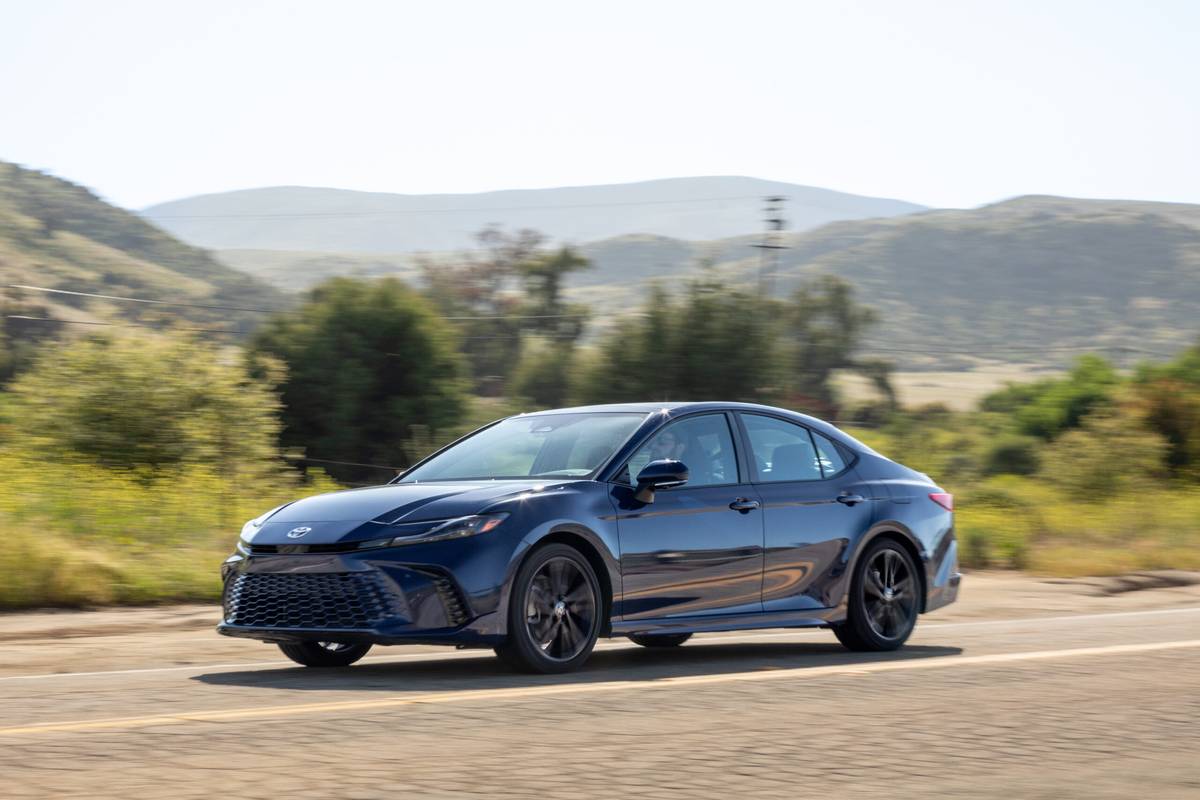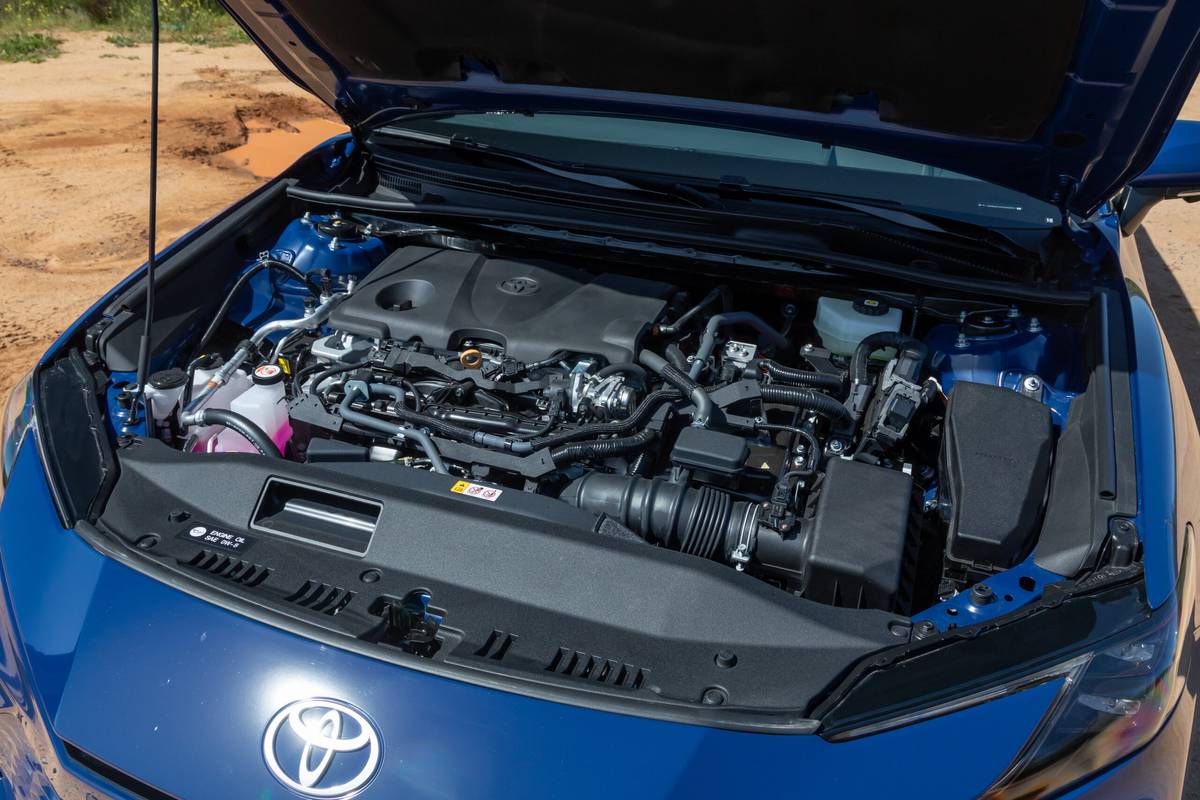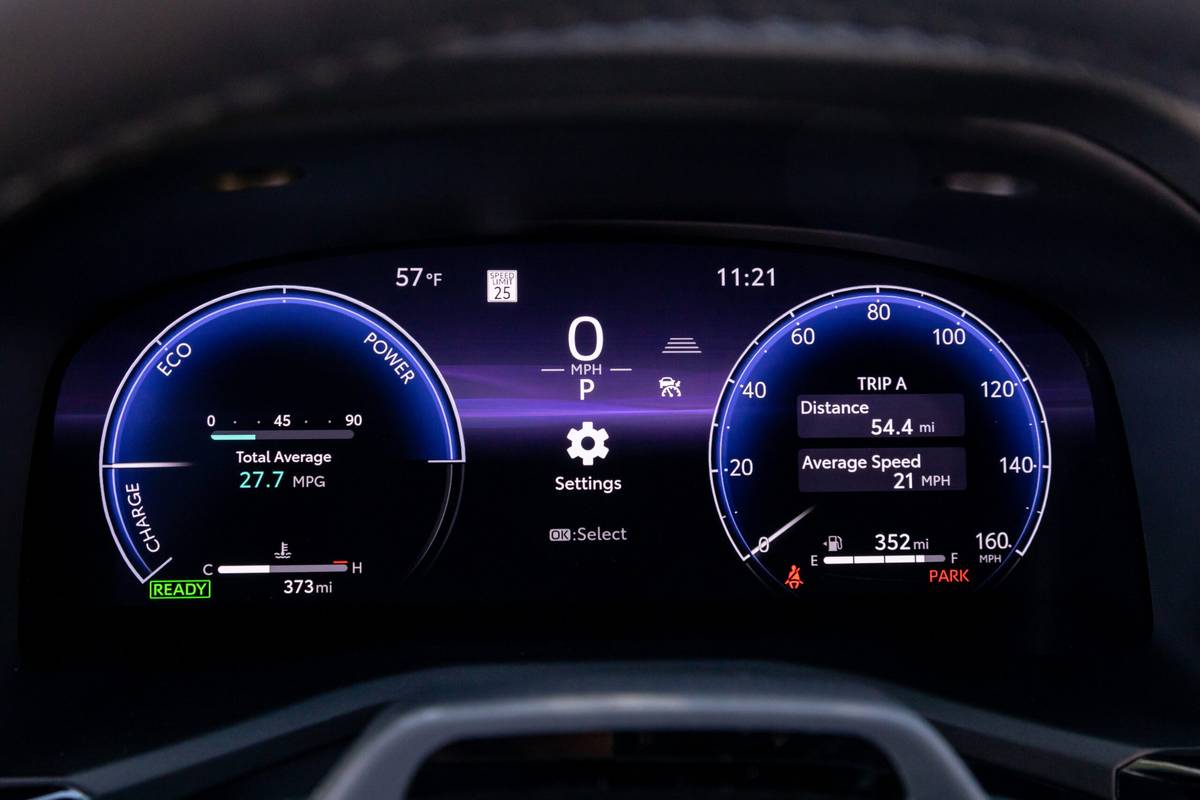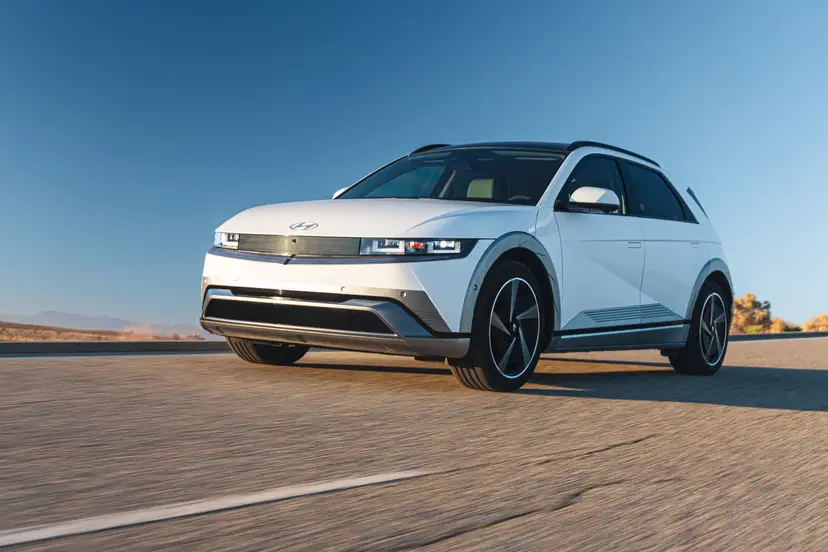
The verdict: We’re going to miss the old V-6, but the refreshed 2025 Toyota Camry’s hybrid-only drivetrain, stylistic rework and impressive uplevel trims make the segment superstar one of the best mid-size sedans you can buy.
Versus the competition: The class is getting smaller, but the 2025 Camry is the freshest in the mid-size sedan segment, though others have their merits. From a value and efficiency perspective, the Camry is king, but look to the Hyundai Sonata for style and the Honda Accord for driving feel.
Why, yes! Folks still buy sedans in 2024. Despite SUVs of all types and trade gulping down more than half of the U.S.’ market share last year, non-luxury sedans are still big business. Just look to the Toyota Camry as the primary bellwether; just over 290,000 buyers snapped up the perennially popular mid-size sedan last year, handily outselling mega-popular SUVs like the Nissan Rogue and Hyundai Tucson.
Related: 2025 Toyota Camry: All Hybrid, All the Time
This was enough sales success to earn a significant refresh for the new model year, but Toyota wasn’t content with leaving the proven formula as-is. So, the new 2025 Toyota Camry is now hybrid-only in the States, with the only drivetrain-related choice being front- or all-wheel drive. This is arguably the Camry’s most significant powertrain shake-up since a V-6 engine was first offered back in 1988.
Power Struggle
Speaking of that beloved sixer — well, it’s dead. That hybridized four-banger is your sole source of propulsion, presenting both good and bad news depending on your preferences. Base fuel economy is, predictably, way, way up, with Toyota estimating the thriftiest FWD Camry LE returning 53/50/51 mpg city/highway/combined, a moonshot away from the outgoing Camry LE’s EPA-estimated 28/39/32 mpg EPA rating.
This is, of course, not a completely fair comparison. Compared with the prior Camry Hybrid LE, the numbers are far closer; the 2024 Hybrid LE sipped fuel to the tune of 51/53/52 mpg. The fifth-generation hybrid system in the 2025 Camry makes more power — 225 horsepower with FWD and 232 hp with AWD — and the system still uses a naturally aspirated 2.5-liter four-cylinder engine. Also rote is the new Camry’s significant mpg spread; between extra weight, suspension changes and aerodynamic differences, the new Camry’s manufactured-estimated fuel efficiency falls as low as 44 mpg combined for the AWD XSE grade.
That’s the good news. The not-so-great news is the distinct lack of a higher-output powertrain option previously filled by the 301-hp V-6. Now, all FWD trims buzz around with 225 hp and at least 163 pounds-feet of torque, with the AWD configuration bumping output to 232 hp. We say “at least” due to Toyota’s persistent refusal to publish combined torque figures, so all we’re left with is that 163 pounds-feet rating for the engine and a separate 153 pounds-feet output for the hybrid system’s electric motor.
It’s a bummer, but if we had to guess, the six joined the great engine dyno in the sky due to a combination of efficiency priorities and likely low take rate when compared with the base four-cylinder model and the popular hybrid. If we’re being goofy for a moment — and we love being goofy — we could see Toyota filling that void with the Crown’s 340-hp Hybrid Max powertrain, perhaps in a forthcoming TRD performance trim.
Related Video:
We cannot generate a video preview.
Same-Same Size
We might be onto something there, at least on the TRD front. Toyota has split the Camry into two distinct suspension configurations, with sportier SE and XSE trims riding on stiffer shocks and incorporating a larger front stabilizer bar. This practice isn’t entirely removed from the prior generation, though Toyota is quite proud of the SE/XSE differentiation this time around.
Dimensionally, there’s not a whole lot different from the old car, with the base LE adding only 1.4 inches in overall length, leaving width, height and wheelbase unchanged. More hybrid hardware to lug around boosts curb weight of the base LE by 140 pounds to 3,450 pounds, but the 2025 XSE with FWD is 42 pounds lighter than the same trim of the 2024 Camry Hybrid.
The same can’t be said stylistically, as Toyota went to town on the new car to make sure you won’t mistake the 2025 Camry for anything else. The new car is more angular and hard-edged than before, wearing a “hammerhead” grille design, according to Toyota. What hasn’t been sharpened is sleekened, especially the headlights and taillights, the former channeling more than a smidge of Prius in the face.
Based on those dimensions and the general appearance, it’s clear most of the structure under the new skin is carried over from the last Camry, but the exterior is peppered with plenty of little details that complement the broader stylistic strokes. Our favorite touches are the micro-canards found at the lower, outer edges of the front bumper that are tres-TRD, even if they’re purely for improved aero efficiency.
Lovely When Loaded
All of this continues to the interior, where you’ll interact with a design language Toyota calls “open-concept.” We interpret that this refers primarily to the cavernous, open portion under the center of the dash and the scalloped portion of the passenger-side dash. Either way, tech and creature comforts are the centerpiece of at least the higher trims; the high-grade Camry XSE we tested was decked out to a genuinely impressive degree.
Given that “Camry” is a rough transliteration of the Japanese word for “crown,” it’s fitting that chunks of the interior appear grafted straight from the Crown premium sedan. Specifically, our test car’s 12.3-inch center infotainment display is right from the bigger, more expensive car, supported by a matching 12.3-inch digital gauge cluster and an optional head-up display.
Top-spec Camrys were always well equipped, but not to this degree. After futzing around, we struggled to find any feature we’d like to see added, enjoying niceties like dual-zone automatic climate control, heated and ventilated power-adjustable leather-trimmed front seats, a panoramic glass roof, wireless charging and a nine-speaker JBL premium audio system. You’re going to pay for the privilege — more on that later — but there is nothing “Camry” about this loaded example. We can’t say the same for lower trims just yet, but we’ll restrict our opinions to what we experienced on the open road.
Haven’t I Driven You Before?
It will come as no surprise that the 2025 Camry drives a whole heck of a lot like, ah, the 2024 Camry with a raft of powertrain improvements. Despite our moaning, the power of the revamped hybrid drivetrain is well beyond what the average buyer requires, with confident passing capability and strong (enough) merging speed. Noise, vibration and harshness are remarkably improved over the outgoing hybrid thanks in no small part to the development team’s focus on boosting battery power to intentionally reduce engine revs during aggressive acceleration.
This makes for a markedly more refined experience. One of the most effective ways to elevate a car past its price is to reduce thrash ‘n gnash, and this goes a long way in this case. For the first time in recent memory, we’re not left pining for better sound isolation after an extended drive in an “affordable” sedan.
Similarly upscale is the Camry’s body composure. Ride quality of the XSE’s sport-tuned suspension is excellent for the class, with well-tuned damping and bump isolation. We’ve long been fans of the Camry’s TNGA-K platform, and maybe we’re just too accustomed to SUVs and ultra-heavy electric vehicles, but for a non-performance car, the 2025 Camry’s confident handling through the California canyons was a breath of fresh air. It’s not a remote replacement for your GR86 or GR Corolla, but you’ll at least crack a half-smile the next time you must meet your weekend hiking crew at that alpine trailhead.
Other elements of the driving experience are more pedestrian but not unexpected, including the continuously variable automatic transmission’s understandable languidness, the artificial steering feel and the noticeable regenerative portion of the brake pedal’s travel. Don’t mistake any of this for derision; the 2025 Camry is exactly what it needs to be and is far better to drive than any SUV could ever hope to be.
More From Cars.com:
- 2025 Toyota Camry Up Close: Still Kicking, Now With Even More Style
- 2024 Hyundai Sonata Vs. 2025 Kia K5 Vs. 2025 Toyota Camry: Auto Show Faceoff
- Toyota Camry Hybrid Vs. Honda Accord Hybrid: Which Is Best?
- 2023 Honda Accord Hybrid Vs. 2023 Toyota Camry Hybrid: Which Gets Better Real-World Gas Mileage?
- Shop for a 2025 Toyota Camry
Sweet Safety
We thankfully never overstepped the car’s capabilities and engaged the rather large suite of active safety features, but we’d be remiss if we didn’t mention that Toyota Safety Sense 3.0 is standard. Aside from all the usual features like automatic high-beam headlights, pre-collision braking, adaptive cruise control, and lane departure warning with steering assist, Proactive Driving Assist is an interesting feature that automatically assists with keeping distance from the car ahead of you and any cyclists you come near. For those trying to win the configurator high score, XLE and XSE trims are available with additional safety tech, including front cross-traffic alert, lane change assist, a 360-degree camera system, and front and rear parking sensors.
Even if you aren’t super careful with the order form, the inevitable pricing increase isn’t too bad when compared with the older Camry. Let’s start with the base LE, which starts at $29,495 (all prices include destination); trim for trim, the 2025 Camry adds a not-insignificant $1,980 compared with the never-gonna-find-it, stripped-out 2024 LE. Ouch, but compare it with the 2024 LE Hybrid, and the new car is cheaper by $455. This type of subtle price difference goes all the way up the chain, with hybrid-to-hybrid differences of $305 and $310 extra for the new XSE and SE trims, and a $345 price decrease for the 2025 XLE.
This pricing pattern is a fitting metaphor for the 2025 Toyota Camry as a whole — some things are vastly different, while others are right where you left them. Toyota’s latest mid-size sedan is an impressive and well-executed update to an automotive touchstone that should (read: hopefully) give the shrinking sedan segment a shot in the arm.
Cars.com’s Editorial department is your source for automotive news and reviews. In line with Cars.com’s long-standing ethics policy, editors and reviewers don’t accept gifts or free trips from automakers. The Editorial department is independent of Cars.com’s advertising, sales and sponsored content departments.






















 Latch
Latch
 Infant
Infant
 Rear-facing Convertible
Rear-facing Convertible
 Front-facing Convertible
Front-facing Convertible
 Booster
Booster







